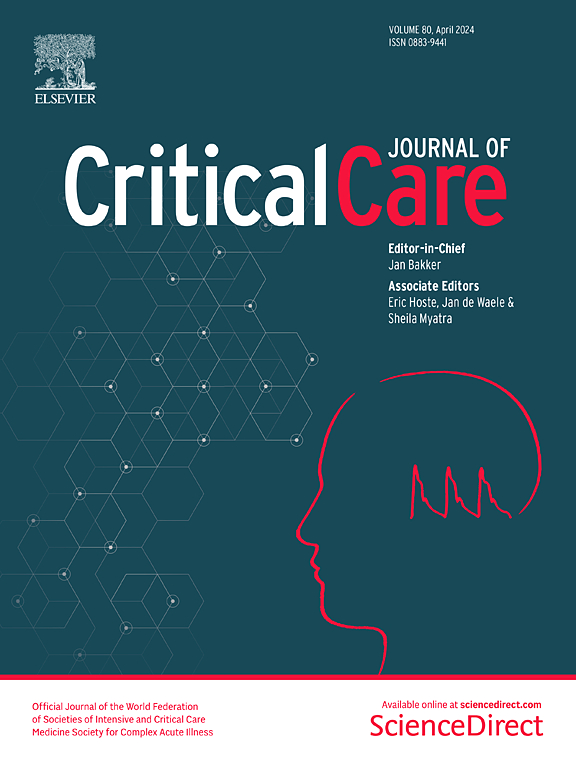SIGH35 and end-expiratory occlusion test for assessing fluid responsiveness in critically ill patients undergoing pressure support ventilation
IF 8.8
1区 医学
Q1 CRITICAL CARE MEDICINE
引用次数: 0
Abstract
Assessing fluid responsiveness is problematic for critically ill patients with spontaneous breathing activity, such as during Pressure Support Ventilation (PSV), since spontaneous breathing activity physiologically affects heart–lung interplay. We compared the reliability of two hemodynamic tests in predicting fluid responsiveness in this clinical setting: SIGH35, based on a ventilator-generated sigh applied at 35 cmH2O for 4 s and the end-expiratory occlusion test (EEOT). Prospective study conducted in a general intensive care unit (ICU) and enrolling patients in PSV showing different inspiratory effort [assessed by airway occlusion pressure (P0.1)] and requiring volume expansion (VE). Hemodynamic variables were recorded by means of the MOSTCARE® system, patient received a VE using 4 ml/kg of crystalloids over 10 min and were considered responders if a cardiac output (CO) ≥ 10% was observed. The reliability of SIGH35 and EEOT in discriminating fluid responsiveness was assessed using receiver operating characteristic (ROC) curve approach and the area (AUC) under ROC curves was compared. For the EEOT, we considered the percent changes of CO between baseline the end of the test, while for the SIGH35, the percent changes of pulse pressure (PP) between baseline and the lowest value recorded after SIGH35 application. Sixty ICU patients were enrolled, and 56 patients analysed. The AUC of PP changes after SIGH35 was 0.93 (0.84–0.99) [sensitivity of 93.1% (78.0–98.7%); specificity of 91.6 (73.0–98.9%)]; best threshold − 25% PP from baseline (grey zone − 15%/35%)]; and greater than the AUC of CO changes after EEOT [0.67 (0.52–0.81); sensitivity of 72.4% (54.3–85.3%) specificity of 70.3% (73.0–98.9%)]; best threshold 4% of CO increase from baseline (grey zone − 1%/10%)]. In the subgroup having a P0.1 < 1.5 cmH2O, the AUC of SIGH35 [0.98 (0.94–0.99)] and of EEOT [0.89 (0.72–0.99] were comparable (p = 0.26). In a selected ICU population undergoing PSV, SGH35 reliably predicted fluid responsiveness and performed better than the EEOT, which is, however, still reliable in the subgroup of ICU patients having a small extent of inspiratory efforts.sig35和呼气末闭塞试验评估压力支持通气危重患者的液体反应性
对于有自主呼吸活动的危重患者,如在压力支持通气(PSV)期间,评估液体反应性是有问题的,因为自主呼吸活动在生理上影响心肺相互作用。我们比较了两种血液动力学试验在预测该临床环境中液体反应性方面的可靠性:基于呼吸机产生的叹息在35 cmH2O下应用4 s的SIGH35和呼气末闭塞试验(EEOT)。在普通重症监护室(ICU)进行的前瞻性研究,纳入了表现出不同吸气力的PSV患者[通过气道闭塞压(P0.1)评估],需要容积扩张(VE)。通过MOSTCARE®系统记录血流动力学变量,患者在10分钟内接受4 ml/kg晶体药物的VE治疗,如果观察到心输出量(CO)≥10%,则认为患者有反应。采用受试者工作特征(ROC)曲线法评价了SIGH35和EEOT在鉴别流体反应性方面的可靠性,并比较了ROC曲线下的面积(AUC)。对于EEOT,我们考虑了测试结束时基线之间CO的百分比变化,而对于SIGH35,脉冲压力(PP)在基线和SIGH35应用后记录的最低值之间的百分比变化。纳入60例ICU患者,分析56例患者。SIGH35后PP变化的AUC为0.93(0.84 ~ 0.99)[灵敏度为93.1% (78.0 ~ 98.7%);特异性为91.6 (73.0 ~ 98.9%);最佳阈值-距基线25% PP(灰色地带- 15%/35%)];且大于EEOT后CO变化的AUC [0.67 (0.52 ~ 0.81)];敏感性为72.4%(54.3-85.3%),特异性为70.3% (73.0-98.9%);最佳阈值:CO较基线增加4%[灰色地带- 1%/10%]。在P0.1 < 1.5 cmH2O的亚组中,SIGH35的AUC[0.98(0.94-0.99)]和EEOT的AUC[0.89(0.72-0.99)]具有可比性(p = 0.26)。在接受PSV的特定ICU人群中,SGH35可靠地预测了液体反应性,并且比EEOT表现更好,然而,EEOT在有小程度吸气努力的ICU患者亚组中仍然可靠。
本文章由计算机程序翻译,如有差异,请以英文原文为准。
求助全文
约1分钟内获得全文
求助全文
来源期刊

Critical Care
医学-危重病医学
CiteScore
20.60
自引率
3.30%
发文量
348
审稿时长
1.5 months
期刊介绍:
Critical Care is an esteemed international medical journal that undergoes a rigorous peer-review process to maintain its high quality standards. Its primary objective is to enhance the healthcare services offered to critically ill patients. To achieve this, the journal focuses on gathering, exchanging, disseminating, and endorsing evidence-based information that is highly relevant to intensivists. By doing so, Critical Care seeks to provide a thorough and inclusive examination of the intensive care field.
 求助内容:
求助内容: 应助结果提醒方式:
应助结果提醒方式:


